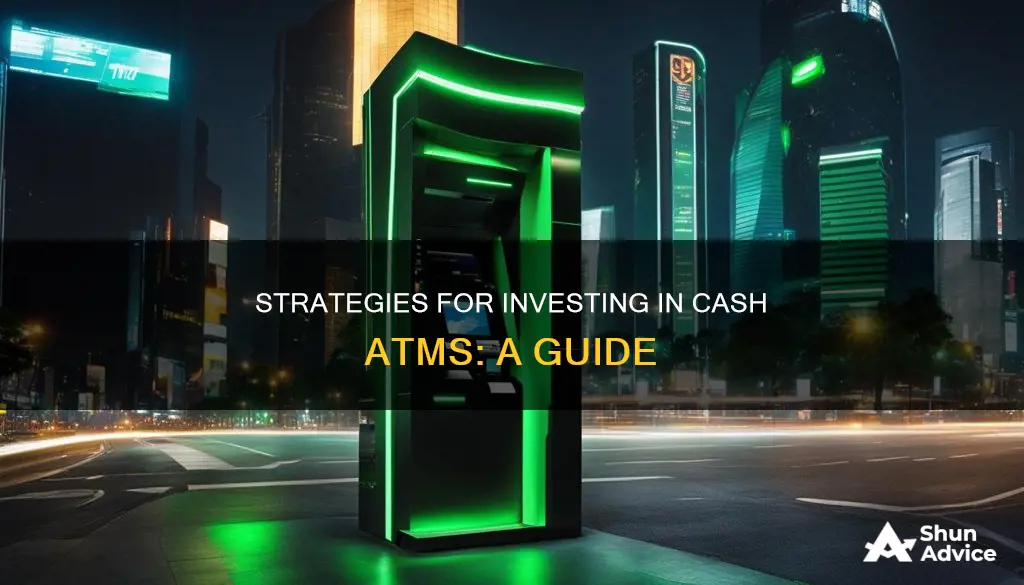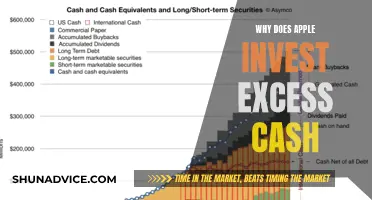
Investing in an ATM can be a lucrative opportunity for those looking to diversify their portfolio. ATMs are an attractive investment option due to their consistent cash flow, large and growing user base, and potential for high returns.
Here's a breakdown of what you need to know about investing in ATMs:
How ATMs Make Money
ATMs generate income through transaction fees, typically between $2 and $3 per withdrawal. The volume of transactions across a portfolio of ATMs drives cash flow for investors.
Who Owns ATMs?
ATMs are primarily owned by two types of groups:
1. Small Businesses: These are mom-and-pop operators who recognize the opportunity to place ATMs in new locations. However, they may struggle with scaling their business and lack historical transaction data for optimal placement.
2. Institutional Operators: These are large operators often controlled by private equity firms, hedge funds, or large institutions. They have established contracts with major retailers and can leverage extensive transaction data to reduce risk.
Investing in ATMs
The fastest way to invest in ATMs is through a fund, where you contribute capital to a portfolio of geographically diverse ATMs. This offers instant diversification, and most ATM funds are passive investments with no operational duties for the investor.
Benefits of Investing in ATMs
- Large and growing user base
- Stable monthly transaction volume
- Potential for consistent cash flow and high returns
- Depreciation-related tax benefits due to the shorter lifespan of ATMs compared to other investments like real estate
- Recession resilience: ATMs are non-correlated assets, meaning their value doesn't fluctuate with traditional markets
- Portfolio diversification
Risks of Investing in ATMs
- Zero equity: ATMs have a short lifespan, so there's no long-term equity gain.
- Inexperienced operations: Success depends on finding skilled operators with a track record in this niche industry.
- Liquidity risk: ATMs are illiquid investments and may be difficult to sell.
Getting Started
If you're considering investing in ATMs, start by researching ATM funds and choosing one that aligns with your financial goals. Consult a financial advisor to ensure this investment strategy suits your risk profile and financial objectives.
What You'll Learn

ATM investment opportunities
Automated Teller Machines (ATMs) are a huge investment opportunity that has been overlooked by many investors. ATMs can be a good investment for a variety of reasons. They serve a large and growing user base, provide consistent cash flow, offer potential for returns that can outperform other investment vehicles, and are considered recession-resilient.
How ATMs Make Money
ATMs generate income through transaction fees, which are usually between $2 and $3 per transaction. The volume of transactions across a portfolio of ATMs drives cash flow for investors. The cash flow is considered stable as it is powered by underbanked individuals who use ATMs as their primary financial service.
Who Owns ATMs?
ATMs are primarily owned by two different types of groups: small businesses and institutional operators. Small businesses see the opportunity to place ATMs in new locations but may lack historical transaction data and struggle to scale. Institutional operators often have established contracts with major retailers and can leverage historical transaction data to reduce risk.
Investing in ATMs
The fastest way to invest in ATMs is through a fund. By participating in an ATM fund, you invest capital in a portfolio of thousands of geographically dispersed ATMs. This offers instant diversification, and the investment is fully passive with no operational duties or obligations.
Benefits of Investing in ATMs
Investing in ATMs offers several benefits, including:
- A large and growing user base
- Relative stability of transaction volume
- Potential for consistent cash flow
- Possible returns that outperform other investments
- Depreciation-related tax benefits due to the shorter lifespan of ATMs compared to other investments
- Diversification of an investor's portfolio
Risks Associated with ATM Investing
As with any investment, there are certain risks to consider before investing in ATMs:
- Zero equity: ATMs have a short lifespan, which is great for depreciation but provides no opportunity to build equity.
- Inexperienced operations: ATM investments require experienced operators with successful track records.
- Liquidity risk: ATMs are illiquid investments, which means they can be difficult to sell.
Getting Started with ATM Investments
If you want to invest in ATM machines, start by researching ATM funds and choosing one that aligns with your financial goals. It is always recommended to consult a financial or legal professional before making such an investment.
Investments and Cash Equivalents: What's the Real Difference?
You may want to see also

ATM funds
Automated Teller Machines (ATMs) are a huge investment opportunity that many investors have failed to take advantage of. They serve a large and growing market, with about 40 ATMs for every 100,000 people around the world, and each ATM is used about 300 times per month.
The fastest path to investing in ATMs is through a fund. By participating in an ATM fund, you invest capital in a portfolio made up of thousands of geographically dispersed ATMs. This offers instant diversification based on the quantity and different locations of the ATMs. The investment is fully passive, with no operational duties or obligations.
ATMs generate income through transaction fees, which are usually between $2 and $3 per transaction. The volume of transactions across a portfolio of ATMs drives cash flow for investors. The cash flow is stable as it is powered by underbanked individuals who use ATMs as their primary financial service.
Who Owns ATMs?
ATMs are primarily owned by two types of groups:
- Small Businesses: These operators are aware of the opportunity presented by placing ATMs in new locations, but performance is less predictable due to a lack of historical transaction data and challenges with scaling their business.
- Institutional Operators: These are large operators, often controlled by private equity firms, hedge funds, and large institutions, that have established contracts with major retailers. They can leverage historical transaction data to reduce risk.
Benefits of Investing in ATMs
- A large and growing user base
- Relative stability of transaction volume
- The potential for consistent cash flow
- Possible returns that outpace other investments
- Depreciation-related tax benefits due to the shorter lifespan of ATMs compared to other investments like real estate
- Recession-resilience: ATMs are non-correlated assets, meaning their value does not change with movements in traditional markets
- Diversification of an investor's portfolio
Risks Associated with ATM Investing
- Zero Equity: ATMs have a short lifespan, so there is no equity to be gained over time.
- Inexperienced Operations: For ATM investments to succeed, finding the right operators with a track record of success in this space is crucial.
- Liquidity Risk: ATMs are illiquid investments, which means they can be difficult to sell.
Getting Started with ATM Funds
If you're interested in investing in ATM funds, the first step is to research available funds and choose one that aligns with your financial goals. It is always recommended to consult with a financial advisor before making such an investment.
Understanding Investment Impacts on Cash Flow Statements
You may want to see also

ATM business rules of thumb
Rule 1: Location, Location, Location
The success of your ATM business depends on where you place your machines. The busier the location, the more withdrawals from the ATM, and the more money you make. High-traffic areas with a high need for cash and no credit card facilities are ideal. Examples include restaurants, liquor stores, convenience stores, fast-food restaurants, bars, nightclubs, train stations, stadiums, hotels, and adult-themed locations.
Rule 2: Foot Traffic and Customer Behaviour
A good rule of thumb is that approximately 2-3% of people who see an ATM in an establishment will use it. So, if your location has 200 customers per day, you can expect around 5 of them to use the ATM. This means that you need at least 3-4 people per day to use your ATM (if available 7 days a week) to make a profit.
Rule 3: Know Your Customer
ATM users are typically individuals with poor or no credit who do not have credit cards, those using prepaid cards, people using electronic benefits transfer (EBT), and individuals who need to transfer funds or conduct transactions without online banking.
Rule 4: Start Small and Grow
You can easily earn $5,000 per month in the ATM business within a couple of years by starting small and gradually expanding. For example, you could aim for 6 machines in your first year and 12 in your second.
Rule 5: Weigh Up the Costs and Benefits of Buying vs. Leasing
Purchasing an ATM is a high cost upfront that pays for itself over time. Leasing an ATM is less expensive upfront but brings in smaller profits as you have to split the surcharge fees with the service company. If you don't mind handling maintenance, buying an ATM will bring bigger income, whereas leasing is better if you want a hands-off approach.
Enhancing Cash Flow: Investing Strategies for Positive Returns
You may want to see also

ATM machine types
There are several types of ATMs, each serving a specific purpose and catering to a particular set of users. Here is a detailed overview of the different types of ATM machines:
On-Site ATMs
On-site ATMs are typically located within or adjacent to bank branches. They offer a comprehensive range of banking services, including cash withdrawals, deposits, balance inquiries, and account transfers. Being situated inside or near a bank ensures that these ATMs are secure and often staffed, providing customers with added peace of mind when conducting transactions.
Off-Site ATMs
Off-site ATMs are strategically placed in locations like shopping malls, airports, or convenience stores, away from bank branches. These machines generally offer limited services, primarily focusing on cash withdrawals and balance inquiries. The purpose of off-site ATMs is to provide convenient access to cash in high-traffic areas, allowing customers to access banking services outside of traditional banking hours.
Orange Label ATMs
Orange Label ATMs are designed specifically for share transactions. They enable customers to conveniently buy and sell shares or manage their investments in the stock market without the need for a broker. These ATMs provide a platform for customers to perform share-related functions independently.
Yellow Label ATMs
Yellow Label ATMs are tailored to support e-commerce transactions. Customers can utilise these machines to pay for online purchases or manage other financial transactions related to e-commerce activities. Yellow Label ATMs bridge the gap between traditional banking and online commerce, providing a seamless payment experience.
Green Label ATMs
Green Label ATMs are intended for agricultural transactions. Farmers and individuals involved in the agricultural sector can use these ATMs for various purposes. This includes obtaining agricultural subsidies, withdrawing funds from agricultural accounts, or conducting transactions directly related to farming activities.
White Label ATMs
White Label ATMs are unique in that they are operated by non-banking entities, often private companies. In India, for example, the TATA Group operates White Label ATMs under the brand name "Indicash." These ATMs offer standard banking services like cash withdrawals but are not affiliated with any specific bank.
Pink Label ATMs
Pink Label ATMs are designed with the safety and convenience of female customers as a priority. These machines are typically placed in secure locations to encourage more women to use banking services independently. Pink Label ATMs aim to provide a safer environment for female customers to conduct their financial transactions.
Brown Label ATMs
Brown Label ATMs are owned by banks but operated by third-party service providers. In this model, the bank handles the branding and cash management, while the service provider takes responsibility for the infrastructure and maintenance. This arrangement allows banks to expand their ATM networks without directly managing the logistics.
Strategizing Initial Investment: Deciding Your First Cash Flow
You may want to see also

ATM business startup costs
The startup costs for an ATM business can vary depending on several factors, including the type of machine, installation, location, and cash reserves. Here is a breakdown of the costs you can expect when starting an ATM business:
- ATM Machine Cost: A standard ATM machine typically costs between $2,000 and $8,000. More advanced models with additional features can exceed $10,000.
- Installation and Setup Fees: You will need to budget between $200 and $500 per machine for professional installation and setup.
- Location Lease or Placement Fees: You can either pay a flat monthly fee for placing your ATM in a business location, which can range from $150 in smaller spots to over $800 in high-traffic areas, or agree to share a percentage of your revenue with the business owner.
- Cash Reserve: You will need a cash reserve to keep your ATMs stocked. It is recommended to have between $2,000 and $10,000 per machine, depending on how often you plan to refill your ATMs and the expected transaction volume.
- Insurance: Expect to spend around $500 to $1,200 annually on ATM insurance to cover potential theft, vandalism, or damage to your equipment.
- Maintenance and Servicing: Set aside between $50 and $100 per month for routine maintenance and service calls to keep your machines running smoothly.
- Compliance and Licensing Fees: Depending on your state, you will need to budget $200 to $2,000 annually for compliance, licensing, and permits required to operate ATMs legally.
- Transportation: You may need to invest in a vehicle for servicing and restocking your ATMs, with costs ranging from $200 to $5,000 or more.
It's important to note that the initial investment for an ATM business can vary widely, and there may be additional costs such as office space, staff fees, and marketing expenses. When starting an ATM business, it's crucial to conduct thorough market research and create a detailed plan to ensure a successful venture.
Cash Investments: Impacting Stockholders Equity Positively
You may want to see also
Frequently asked questions
New ATMs typically cost between $2,000 and $4,000, but prices can go as high as $10,000 depending on the model and features. Used or refurbished machines are cheaper, ranging from $500 to $1,200, but may lack modern security features.
The main types of ATMs are freestanding, countertop, and through-the-wall (TTW) machines. Freestanding machines are the most expensive, followed by countertop machines, and then TTW machines.
On average, a single ATM generates about $540 per month, with the average surcharge fee being $3 and the average number of transactions per month being 180.
Place your ATM in a high-traffic location to maximise transactions. If the ATM is for your business, place it near an entryway, cash register, or restroom to grab attention. If you're purchasing an ATM independently, negotiate a contract with a convenience store or drug store as these are popular spots.
There are several expenses to consider when owning an ATM, including a dedicated phone line, cash refill services, additional cash cassettes, vendor fees, replacement receipt paper, and maintenance and repair costs.







